Key takeaways:
- Photo compositing is a powerful storytelling technique that combines multiple images to evoke emotions and narratives.
- Mastering basic techniques like layers, blending modes, and masks is essential for successful compositions.
- Adobe Photoshop is the preferred software for compositing, but alternatives like Affinity Photo and GIMP are also viable.
- Common challenges in compositing include achieving seamless blends and managing perspective, which require careful attention to detail and planning.
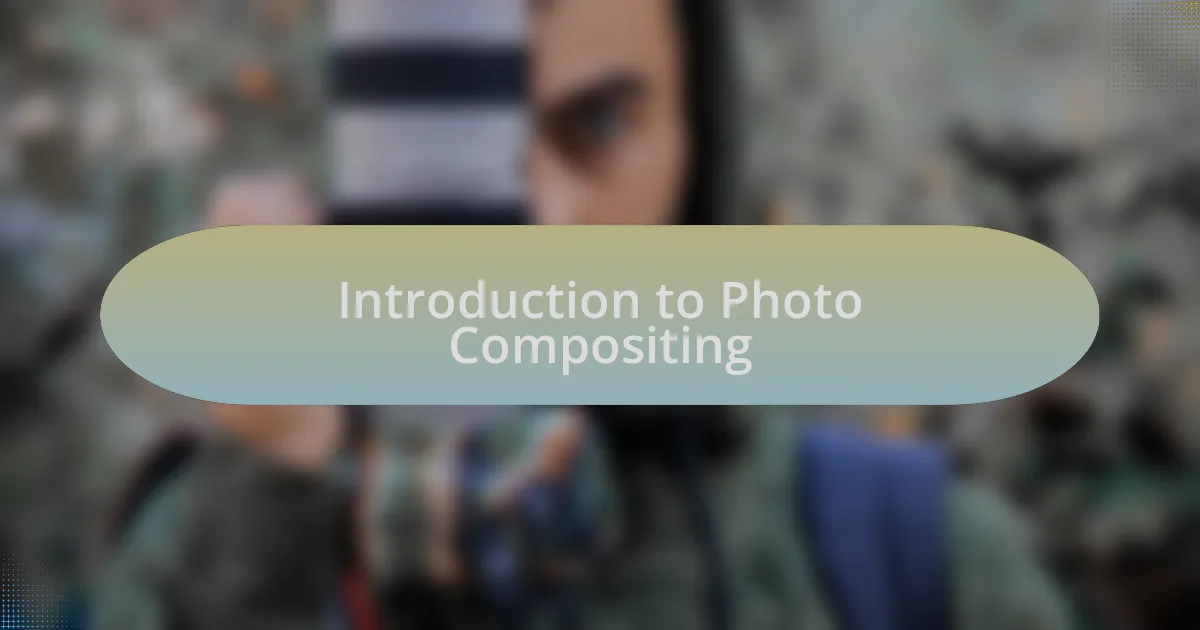
Introduction to Photo Compositing
Photo compositing is an art that combines multiple images to create a single, compelling piece. I remember the first time I experimented with this technique; it felt like a virtual puzzle. I was captivated by the idea that I could blend different elements—like a vivid sunset from one photo and the silhouette of a cityscape from another—to evoke emotions that neither image could convey alone.
As I delved deeper into compositing, I realized it’s not just about layering images; it’s about storytelling. Each element you choose adds a new layer of meaning, inviting viewers to interpret the image in their own way. Have you ever looked at a composite and found yourself drawn into its narrative? I find that the ability to guide the viewer’s emotions through thoughtful composition is what makes this technique so powerful.
The technical aspects, like blending modes and masks, can seem daunting at first, but I promise the learning curve is worth it. Each project has challenged my creativity, pushing me to explore fresh ideas and techniques. What if we approached our compositions not just as photographers but as visual storytellers? That’s where the magic happens—a seamless blend of technical skill and artistic vision.
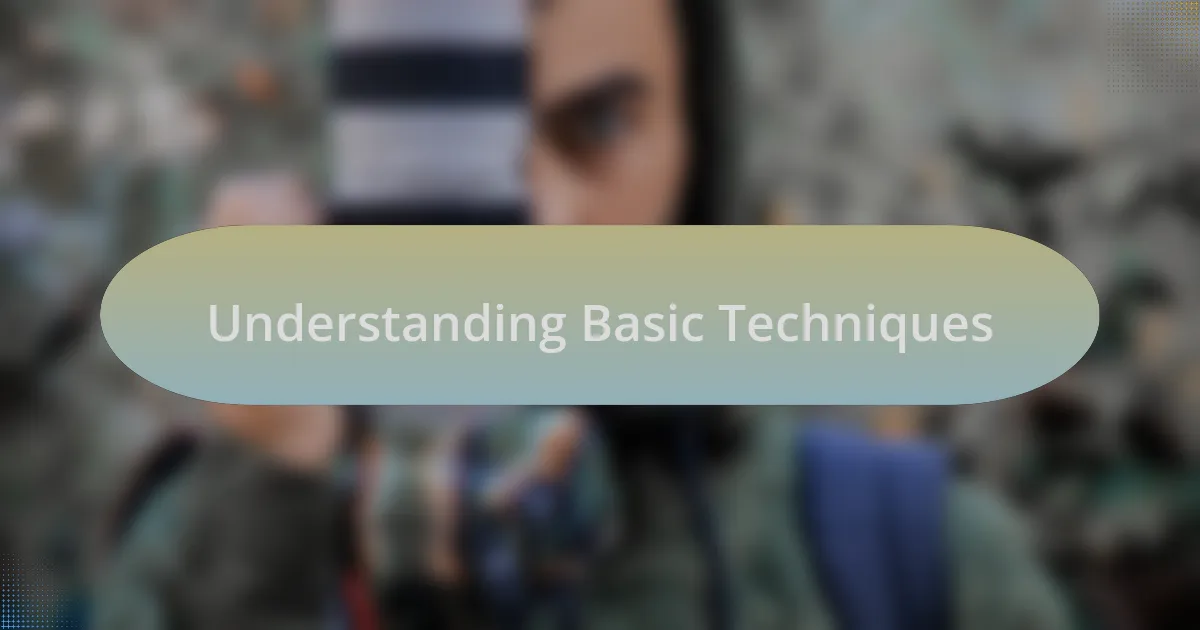
Understanding Basic Techniques
Understanding the basics of photo compositing starts with mastering layers. I remember feeling overwhelmed at first as I stacked images upon images, wanting everything to blend seamlessly. It took time, but I learned that each layer is like a different chapter in a story; each needs its moment to shine, allowing the viewer to navigate through the visuals without feeling cluttered.
Blending modes are another crucial technique that can really elevate your work. At first, I didn’t think much about them, but then I discovered how a simple change in blending mode could transform an image. It’s like finding the perfect spice for a dish; it enhances the flavors without overwhelming the original ingredients. Have you ever tried applying different blending modes and felt such a drastic change that you almost couldn’t recognize your own work?
Masks are invaluable for fine-tuning your compositions. I often use masks to selectively reveal or hide parts of an image, which allows for an element of control that I find liberating. Reflecting on my own journey, the first time I used a mask to smooth out a harsh edge in a composite, I felt a sense of empowerment. It’s about giving yourself the freedom to experiment—what if you took a risk and painted with your masks instead of just clicking through options? Embracing this control can be a game changer for your artistry.
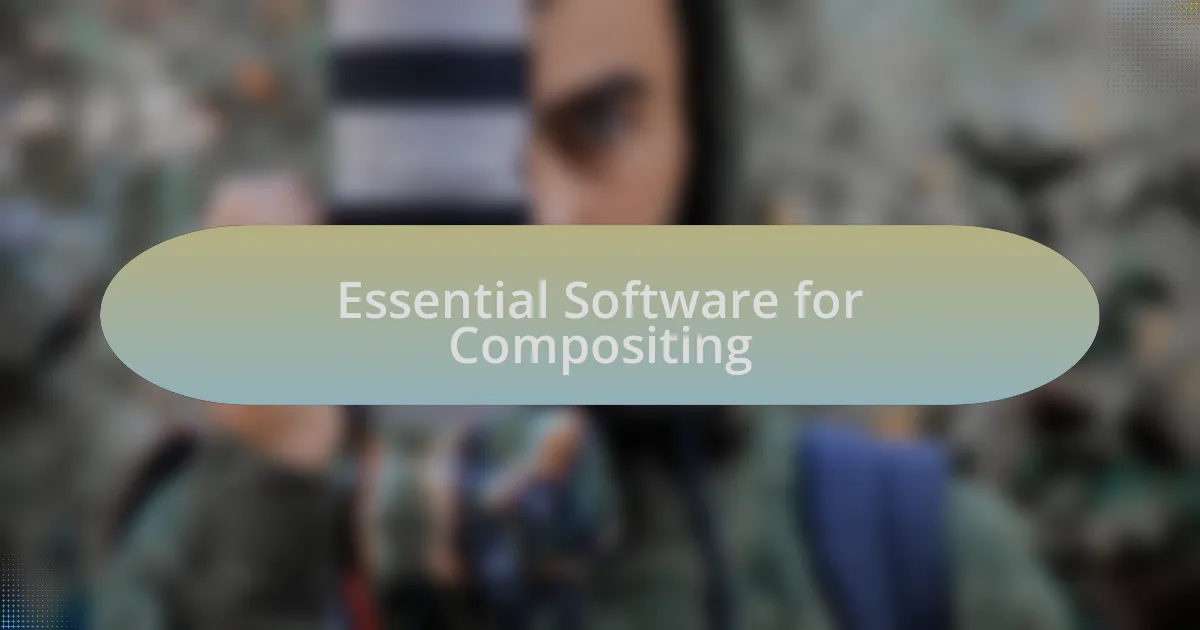
Essential Software for Compositing
When it comes to essential software for compositing, I’ve found Adobe Photoshop to be the gold standard. Its extensive toolset allows you to manipulate images with precision, whether you’re adjusting layers or applying effects. I still remember the first time I experimented with the Puppet Warp tool; it was like having the power to reshape reality itself—how exhilarating it felt to stretch an arm or tilt a head just right!
However, I wouldn’t disregard programs like Affinity Photo or GIMP, especially if you’re looking for budget-friendly alternatives. I recently worked on a project using Affinity Photo, and I was amazed at how professional the tools felt, almost like I was experiencing the same thrill as when I first opened Photoshop years ago. Have you ever explored a new software and felt that rush of creativity? It can be refreshing and invigorating to step outside your comfort zone.
Another standout for me is Adobe After Effects, particularly when I’m looking to incorporate animation into my composites. I vividly recall a project where I animated clouds drifting across a cityscape I had created. The sense of bringing a static image to life was pure magic. If you’re aiming for dynamic visuals, this software truly unlocks limitless possibilities.

Tips for Effective Composition
To create effective compositions, I’ve learned that understanding the rule of thirds can be a game-changer. Imagine dividing your image into thirds, both horizontally and vertically, then placing the main subject along those lines or at their intersections. This technique creates balance and draws the viewer’s eye to important elements in a natural way. I still remember the first time I applied this method—my photos suddenly felt more dynamic and engaging, as if they had a life of their own.
Another tip is to pay attention to depth through layering. By incorporating foreground, middle ground, and background elements, I can give my compositions a three-dimensional quality. I always think back to a stunning sunset I captured where I layered silhouettes of trees in front of the fading light. That added sense of depth not only made the image more striking but also drew viewers in, making them feel as if they could step right into the scene. Have you tried experimenting with layers in your own work? It’s a small adjustment that can yield profound results.
Lastly, never underestimate the power of color grading in your composition. Adjusting the hues and tones can evoke specific emotions and set the mood of the piece. I distinctly recall a project where I used a warm color palette to convey nostalgia, and it transformed the overall feel of the image. The shift was remarkable; it felt like the photograph whispered stories from the past. Have you considered how color influences the emotional impact of your work? Embracing color grading can truly elevate your composites to another level.
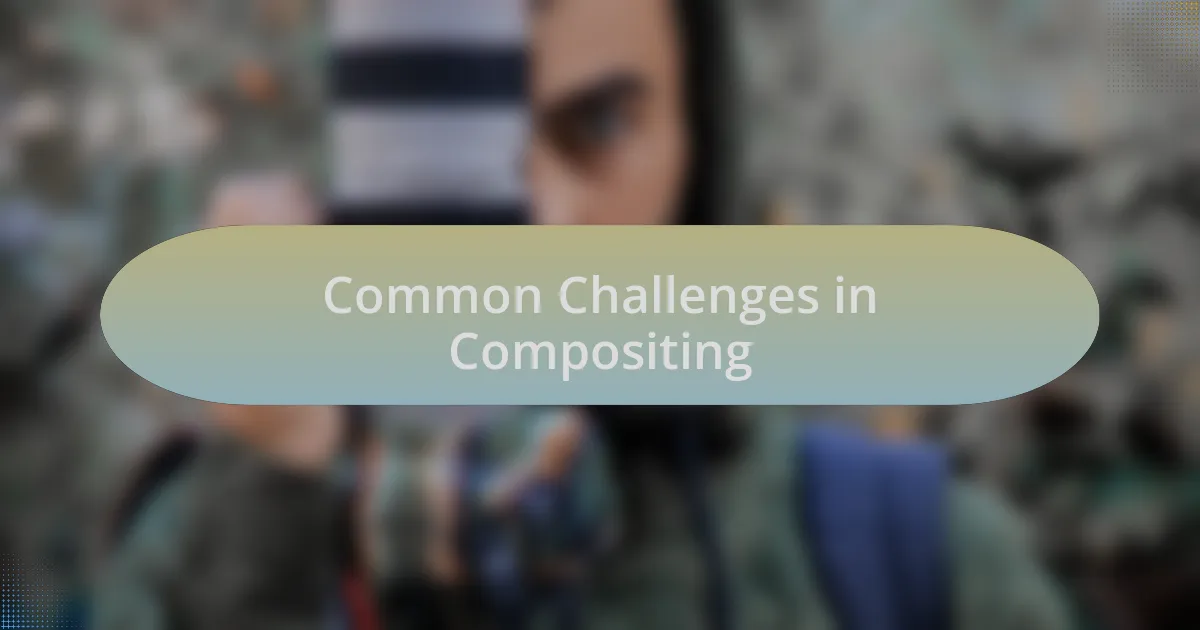
Common Challenges in Compositing
When I dive into photo compositing, one common challenge that often arises is achieving a seamless blend between various elements. I vividly recall a project where I struggled to unify disparate images of a mountain landscape and a starry sky. It was frustrating to see them clash rather than complement each other. I realized that matching the light and shadow between these images is crucial—something that might seem minor but can make or break the final composite. Have you ever faced the same dilemma with blending?
Another hurdle I frequently encounter is perspective distortion. There’s nothing worse than realizing that the elements in my composition don’t align correctly in terms of scale and depth. During one of my earlier attempts, I mistakenly placed a tiny subject too close to a larger object, creating confusion about where the viewer’s focus should lie. I’ve since learned the importance of visual consistency; ensuring that all elements share a common vanishing point can greatly enhance the believability of the scene. Have you ever considered how perspective impacts the storytelling aspect of your work?
Finally, timing can often be a hidden enemy in the compositing process. I remember working on a series of images capturing a sunset over a busy city skyline. While I was focused on getting the perfect skyline shot, the sky’s colors shifted dramatically, and I missed that golden moment. It taught me the value of being prepared and knowing when to capture elements to ensure they harmonize. Have you had moments where timing played a crucial role in your compositing success? Planning ahead can often be the key to transforming an ordinary scene into something truly extraordinary.
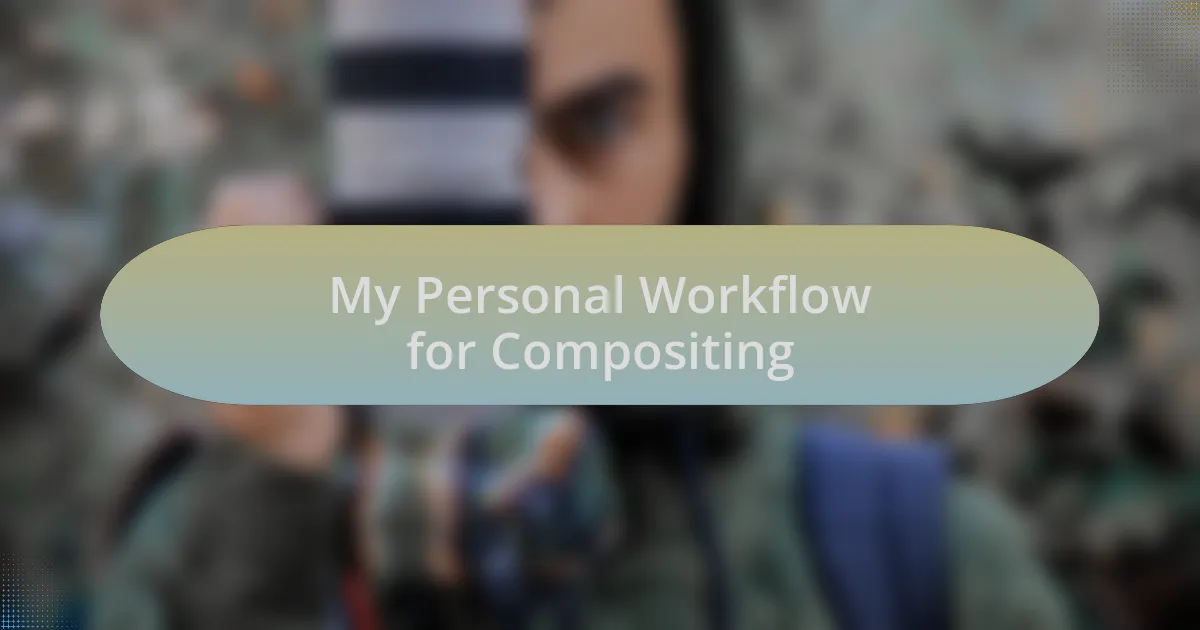
My Personal Workflow for Compositing
When I start a compositing project, I like to organize my workflow into clear stages. I usually begin with brainstorming ideas and sketching rough layouts, which helps me visualize the final image. I can’t tell you how many times laying out my thoughts on paper has saved me from getting lost in the creative chaos. Have you ever found that sketching out your ideas makes a more complex task feel manageable?
Once I’ve settled on a concept, I move to selecting my assets. I often revisit my archives for images that could fit seamlessly into my vision. Recently, I unearthed some old portraits that, with the right background, turned into a magical fantasy piece. Finding those hidden gems always reignites my passion and inspires me to think outside the box. Have you experienced that thrill when an unexpected photo transforms your composition?
Next comes the nitty-gritty of blending everything together. I rely heavily on layer masks and adjustment layers to refine the scene. I once spent hours meticulously blending foliage into a background, and the satisfaction I felt when it finally looked organic was immense. It reinforced my belief that patience pays off in compositing. Have you felt that rush of excitement when you achieve a perfect blend that enhances the overall impact?
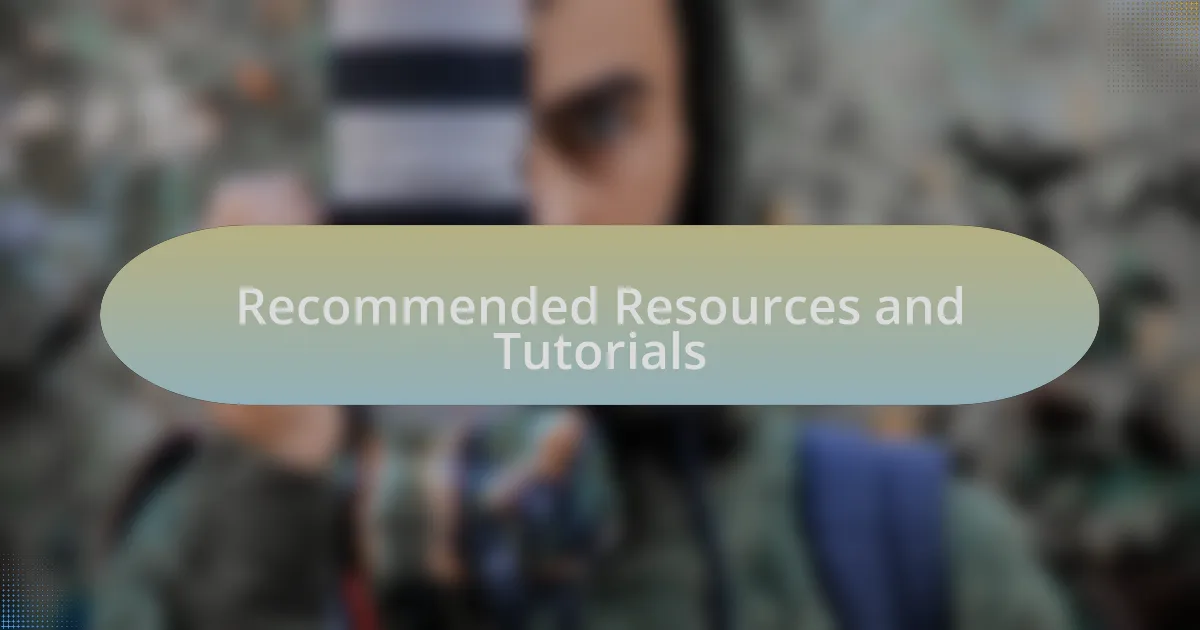
Recommended Resources and Tutorials
When it comes to learning more about photo compositing, I’ve found that YouTube is a treasure trove of resources. Channels like “Phlearn” and “Piximperfect” offer valuable tutorials ranging from beginner techniques to advanced tricks that have truly transformed my approach. Have you ever paused a video to practice along with it? That hands-on experience can really solidify your understanding, making the learning process feel less like a chore and more like an exciting challenge.
Books are another fantastic resource. One of my favorites is “Creative Photoshop: A Complete Guide to Professional Results” by David G. Smith. I remember how each chapter unveiled new tools and techniques that boosted my skills immensely. For those who prefer tactile learning, diving into a well-structured book can spark that creative fire just as effectively as any video.
Lastly, joining photography forums can be incredibly beneficial. I often engage in discussions on platforms like Reddit and specialized photography forums where members share their own compositions and critiques. There’s something electrifying about receiving feedback on my work. Have you ever had a discussion that reshaped your perspective? The collective knowledge within these communities can open your eyes to techniques you may have never considered before.